#Kuiper Belt
Text

Comet C/2023 P1 (Nishimura) // ulli-fee
#astronomy#astrophotography#solar system#icy body#comet#kuiper belt#C/2023 P1 (Nishimura)#Comet Nishimura
553 notes
·
View notes
Text
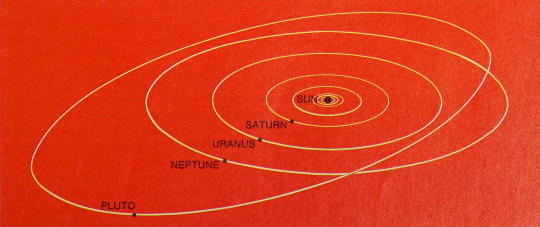
"Pluto was the first planet discovered by mathematical calculations. Its eccentric orbit is different from any other planet's orbit in the solar system."
Earth Science. 1970.
Internet Archive
#solar system#pluto#astronomy#kuiper belt#diagram#concentric circles#textbook illustration#orange#nemfrog#1970#1970s
560 notes
·
View notes
Text
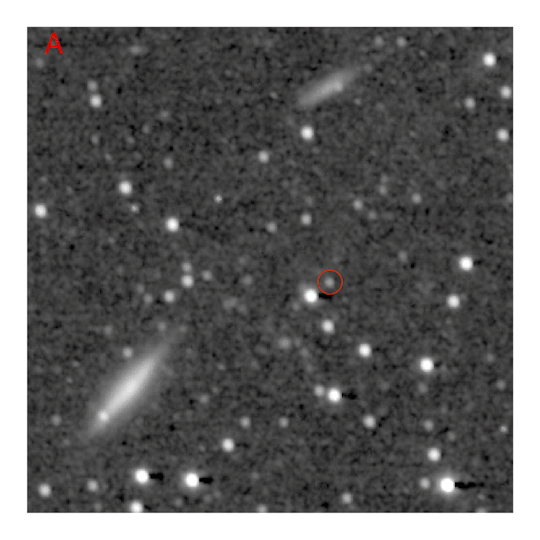
New Horizons: observations of Kuiper Belt object Quaoar, which - at 690 miles or 1,100 kilometers in diameter - is roughly half the size of Pluto (September 4, 2023)
#quaoar#new horizons#krakenmare#kuiper belt#astronomy#astrophotography#outer space#nasa#thank you nasa#space
140 notes
·
View notes
Text


Pluto is the largest known dwarf planet in the solar system and used to be considered the ninth and most distant planet from the sun.
The strange world is located in the Kuiper Belt, a zone beyond the orbit of Neptune brimming with hundreds of thousands of rocky, icy bodies each larger than 62 miles (100 kilometers) across as well as 1 trillion or more comets.
Pluto stopped being a planet in 2006 when it was reclassified as a dwarf planet, a demotion that attracted controversy and stirred debate in the scientific community and among the general public.
American astronomer Percival Lowell first suggested that Pluto existed in 1905 when he observed strange deviations in the orbits of Neptune and Uranus.
Lowell thought there must be another whose gravity is tugging on these ice giants, causing discrepancies in their orbits.
Lowell proceeded to predict the mystery planet's location in 1915 but died 15 years before its discovery.
Pluto was eventually discovered in 1930 by Clyde Tombaugh at the Lowell Observatory, based on predictions by Lowell and other astronomers.
Pluto got its name from 11-year-old Venetia Burney of Oxford, England, who suggested to her grandfather that the new world get its name from the Roman god of the underworld.
Her grandfather then passed the name on to Lowell Observatory. The name also honors Percival Lowell, whose initials are the first two letters of Pluto.
Via space.com
#Pluto#New Horizons#space#planet#astronomy#New Horizons spacecraft#NASA#space probe#Kuiper Belt#Neptune#Percival Lowell#Clyde Tombaugh#Lowell Observatory#Venetia Burney#dwarf planet
162 notes
·
View notes
Photo

Astronomers puzzle over dwarf planet ring system • The Register
Structure appears to be so far out, the Roche limit may need revising
A ring system has been spotted around dwarf planet Quaoar at a distance astronomers didn't believe was possible, defying astronomical theories on how these structures form.
Quaoar lies in the Kuiper belt beyond Neptune. The icy rock is 1,121 kilometers (697 miles) wide, about half the diameter of Pluto. Quaoar is a distant object with interesting properties, including signs it may harbor ice-spewing volcanoes and a ring system.
Debris compressed into rings orbiting planets are found around the gas giants Saturn, Jupiter, Uranus and Neptune, and dwarf planets Chariklo and Haumea. All the ring systems lie relatively close to their host planets within a distance known as the Roche limit.
The Roche limit states that ring systems can only form within a distance where the tidal forces from a larger body are more powerful than a smaller object's own gravitational forces. In short, debris captured inside a planet's Roche limit will be ripped apart and compressed into a ring system. Any material outside this distance, however, will more likely stick together under gravity and form a moon instead.
Quaoar, however, breaks this rule. Its ring system is intact at orbits at a distance over seven times the dwarf planet's radius. Saturn's ring system is located at a distance only three times its radius, for comparison. Now astronomers are puzzled over how such a ring system can survive so far from its parent body. ...
200 notes
·
View notes
Text
One of my sisters got me Cat’s Cosmic Atlas for my birthday. It’s tomorrow but we celebrate early if it’s not on the weekend.
(Game by RedDeer.Games)


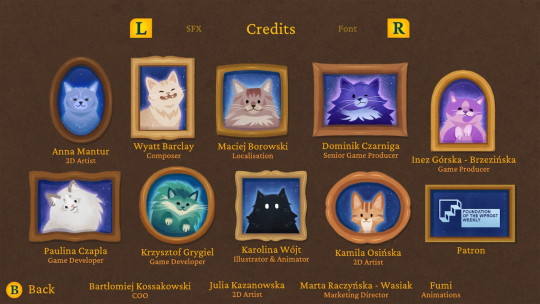
It’s a super cute and fun game so far. I haven’t played a space game in a long time. The last one was Magic School Bus Explores the Solar System (1994) and Pluto was still considered a planet back then!

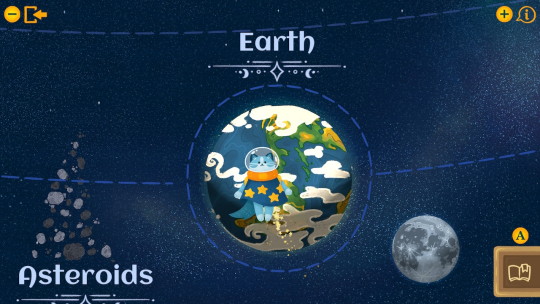
You can fly through the solar system in the game. I was trying to find the Kuiper Belt and found a black hole.
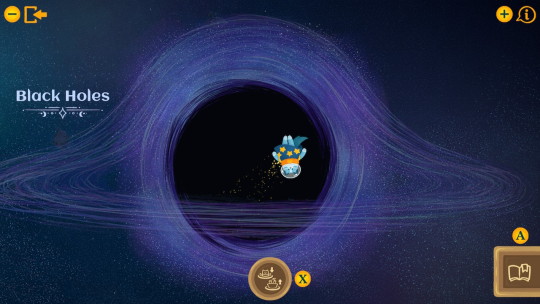
If you go inside you’re taken back to the inner planets. If black holes weren’t inescapable and deadly that would be pretty handy in real life.
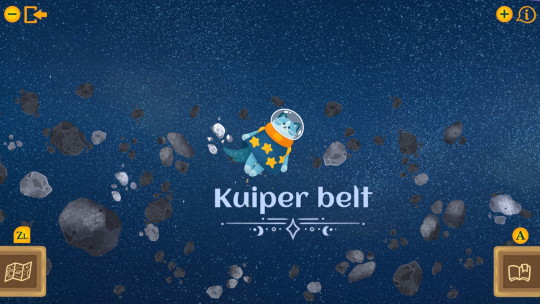
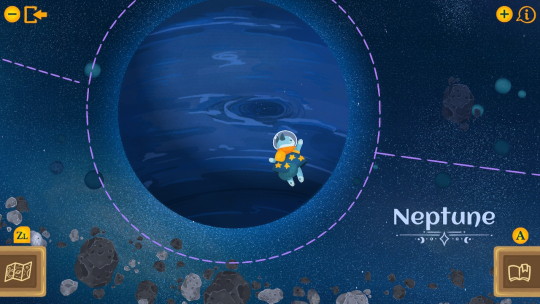
You can give the planets a hug! (I’ll just pretend I gave Pluto a hug too.)
You can also visit constellations in the Northern and Southern skies.

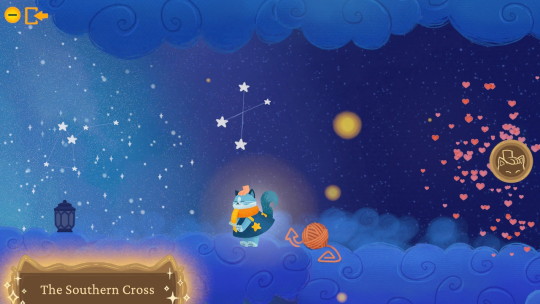


It’s on Steam too if anyone wants to check it out. My sister also got me Little Mouse’s Encyclopedia which is more of a nature hike game which I also love. It looks a bit like Alba’s Wildlife Adventure, which was a fun game too.
#Cat’s Cosmic Atlas#space#astronomy#constellations#solar system#planets#Kuiper Belt#screenshots#video#Nintendo Switch#Long post
11 notes
·
View notes
Text
The New Horizons team is gaining more confidence in their potential detection of a second Kuiper Belt. It’s a very exciting discovery, it means our solar system is a whole lot bigger! However, there wasn’t new data involved with the increase in confidence, so I have to wonder if it’s not a *little* motivated by their recent budget only allowing one more year to search for a third flyby target…
Regardless of that reasoning however, the existence of an outer Kuiper Belt, beyond what was once considered its end, is tantalizing, and I feel the evidence shows promise! Who knows, maybe this is the year New Horizons finds itself a third target, and it will be a member of a region we didn’t even know existed when the little probe launched!
P.S. if you’re a follower you may be interested to know, but the Minor Planet Center verified just one more little moon of Saturn, a cherry on top bringing the count to 146 :)
39 notes
·
View notes
Text
What is the Kuiper Belt?
The Kuiper belt is a circumstellar disc in the outer Solar System, extending from 30 AU (just beyond the orbit of Neptune) to at least 100 AU from the sun. An object found in the Kuiper belt is appropriately called a Kuiper belt object (KBO).
It is similar to the asteroid belt, but is far larger—20 times as wide and 20–200 times as massive. Like the asteroid belt, it consists mainly of small bodies or remnants from when the Solar System formed.
While many asteroids are composed primarily of rock and metal, most Kuiper belt objects are composed largely of frozen volatiles (termed "ices"), such as methane, ammonia, and water.
The Kuiper belt is home to most of the objects that astronomers generally accept as dwarf planets: Orcus, Pluto, Haumea, Quaoar, and Makemake. Some of the Solar System's moons, such as Neptune's Triton and Saturn's Phoebe, may have originated in the region.

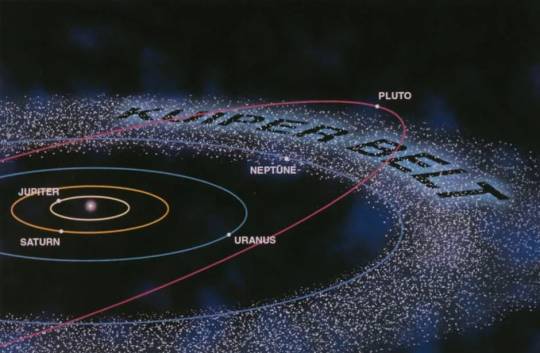
‼️The Kuiper Belt shouldn't be confused with the Oort Cloud, which is a much more distant region of icy, comet-like bodies that surrounds the solar system, including the Kuiper Belt. Both the Oort Cloud and the Kuiper Belt are thought to be sources of comets.
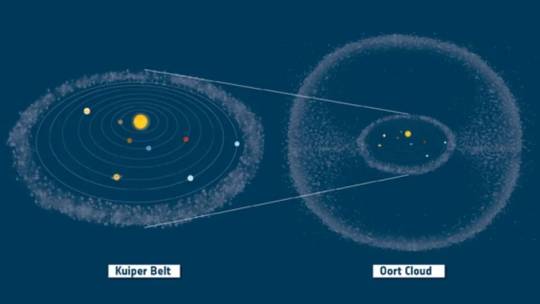
• Why is it important?
One of the most important aspects to the Kuiper Belt is the look it offers into the formation of our solar system. By studying the Kuiper Belt, scientists may be able to better understand how planets and planetesimals – the building blocks of the planets – were formed. The New Horizons spacecraft sent data about the ancient Kuiper Belt object Arrokoth (2014 MU69).
‼️Scientists said just as fossils reveal the formation of life on earth, objects such as Arrokoth show how planets formed in space.
#kuiper systems#kuiper belt#astronomy#hubble#nightsky#solar system#science#nasa#constellations#astrophysics#history#greek mythology#neptune#oort cloud
270 notes
·
View notes
Text
no I didn't cry when I was six and they said Pluto wasn't a planet anymore who told you that I didn't cry it's still a planet in my heart. The IAU may have their definition but they'll never have the streets.
#pluto#astronomy#planets#planet#dwarf planet#kuiper belt#international astronomical Union#pluto nevermore#solar system
8 notes
·
View notes
Text
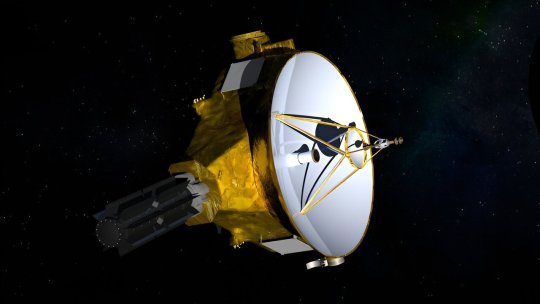
New Horizons to continue exploring outer solar system
NASA has announced an updated plan to continue New Horizons' mission of exploration of the outer solar system.
Beginning in fiscal year 2025, New Horizons will focus on gathering unique heliophysics data, which can be readily obtained during an extended, low-activity mode of operations.
While the science community is not currently aware of any reachable Kuiper Belt object, this new path allows for the possibility of using the spacecraft for a future close flyby of such an object, should one be identified. It also will enable the spacecraft to preserve fuel and reduce operational complexity while a search is conducted for a compelling flyby candidate.
"The New Horizons mission has a unique position in our solar system to answer important questions about our heliosphere and provide extraordinary opportunities for multidisciplinary science for NASA and the scientific community," said Nicola Fox, associate administrator for NASA's Science Mission Directorate in Washington. "The agency decided that it was best to extend operations for New Horizons until the spacecraft exits the Kuiper Belt, which is expected in 2028 through 2029."
This new, extended mission will be primarily funded by NASA's Planetary Science Division and jointly managed by NASA's Heliophysics and Planetary Science Divisions.
NASA will assess the budget impact of continuing the New Horizons mission so far beyond its original plan of exploration. As a starting point, funding within the New Frontiers program (including science research and data analysis) will be rebalanced to accommodate extended New Horizons operations, and future projects may be impacted.
Launched on January 18, 2006, NASA's New Horizons spacecraft has helped scientists understand worlds at the edge of our solar system by visiting the dwarf planet Pluto (its primary mission) and then venturing farther out for a flyby of the Kuiper belt object Arrokoth, a double-lobed relic of the formation of our solar system, and other more remote observations of similar bodies.
12 notes
·
View notes
Text

Best Regards
Can The Sun Rays Be Created By The Gravitational Waves Motions Energies?
or
or
or
or
My theory (the hypothesis)
The Sun Is A Phenomenon Created By The Planets Motions
The Sun Is NOT Doing Nuclear Fusion To Produce Its Rays- instead- The Planets Motions Energies Total Is Used To Produce The Sun Rays
The sun is a phenomenon created by the planets motions – the sun is created after all planets creation and motion – the sun is a phenomenon and its life and death depends on a cycle-means- after this sun death another sun will be created for the solar system
(No Planet Moves By The Sun Gravity– Newton is wrong)
The Sun Rays Production Machine Details
The Sun Rays Are Produced By The Gravitational Waves Motion
The Proof
This Is Extraordinary: Gravity Can Create Light, All on Its Own
https://www.msn.com/en-us/news/technology/this-is-extraordinary-gravity-can-create-light-all-on-its-own/ar-AA19YL5d?ocid=hpmsnHYPERLINK "https://www.msn.com/en-us/news/technology/this-is-extraordinary-gravity-can-create-light-all-on-its-own/ar-AA19YL5d?ocid=hpmsn&cvid=620db4352aa943e2b454919a7b724604&ei=83"&HYPERLINK "https://www.msn.com/en-us/news/technology/this-is-extraordinary-gravity-can-create-light-all-on-its-own/ar-AA19YL5d?ocid=hpmsn&cvid=620db4352aa943e2b454919a7b724604&ei=83"cvid=620db4352aa943e2b454919a7b724604HYPERLINK "https://www.msn.com/en-us/news/technology/this-is-extraordinary-gravity-can-create-light-all-on-its-own/ar-AA19YL5d?ocid=hpmsn&cvid=620db4352aa943e2b454919a7b724604&ei=83"&HYPERLINK "https://www.msn.com/en-us/news/technology/this-is-extraordinary-gravity-can-create-light-all-on-its-own/ar-AA19YL5d?ocid=hpmsn&cvid=620db4352aa943e2b454919a7b724604&ei=83"ei=83
This new article tells - the gravitational waves can move by high velocity motion and can produce A Light Beam– means- the light beam can be created by high velocity motion.
I claim the Sun Rays Are produced by this method and the Sun is NOT Doing Nuclear Fusion to produce its rays.
Shortly- The Sun Rays Are Produced By The Gravitational Waves Motion Energy And No Nuclear Fusion Is Used For The Sun Rays Production.
There are relativistic effects in the solar system proves a high velocity motion is found in the solar system- that supports the article discovery- means- because the gravitational waves move by high velocity– this motion causes to create the relativistic effects which effect on the planets data- and this high velocity motion causes to produce the light beam (The Sun Rays)
(I prove the relativistic effects are found in the solar system in POINT NO.5)
Conclusion No.1- The article changes the light beams production machine from (The Sun Nuclear Fusion) into (The Gravitational Waves High Velocity Motion) – that disproves Immediately The Sun Nuclear Fusion Theory
The Gravitational Waves Are Produced By The Planets Motions Energies and NOT by The Sun Gravitational Field- Moreover - The Sun doesn't create a gravitational field- this fact I prove it here by many major proves (Point NO.1)
Conclusion No.2- My theory tells (The Gravitational Waves Are Produced By The Planets Motions Energies And Not By The Sun Gravitational Field)
This theory changes the sun rays source of energy- in place of the sun mass which is used in (the sun nuclear fusion) to produce the sun rays-
The fact is that- the planets motions energies total is used as the source of energy to produce the sun rays-
Means
The Light Beam Production Machine And Source Of Energy Are Changed Prove That The Sun Nuclear Fusion Theory Is A Fake And Wrong Theory.
Shortly
The Sun Is A Phenomenon Created By The Planets Motions- And The Sun Rays Is Created By The Planets Motions Energies Total-
The Sun Rays are produced by the planets motions energies total (The proves discussion) (Point NO.2)
The gravitational waves move by speed of light (300000 km/s) depends on the planets motions (Point NO.3)
The Planets Motions Use Different Rates Of Time (Point NO.4)
Preface (Proved Facts)
The Rate Of Time Use Reason (The Solar System Creation Theory)
The Planet Creation and Motion Description
The Difficulty To Prove The Rate Of Time Use
The Rate Of Time Importance And Creation
The Energy Reflection Effect On The Rates Of Time
(The Energy Reflection is explained and proved in Point No.6)
The Solar System Main Rates Of Time
The Solar System Motion Depends on Mercury Clock
The Time Creation In The Solar System
The Earth Motion Effect On The Planets Motions Rates Of Time
The Rate Of Time Between Mercury And The Earth
The Rate Of Time Between Mercury And The Sun
The Rate Of Time Between The Sun And The Planets
The Rate Of Time Between The Sun And The Earth
Mercury behaves in place of the sun and The Earth in place of the planets
The Rate Of Time Of Saturn
The Rate Of Time Of Mars
The Solar System Motion During 24 Hours Of Mercury Clock
The Rate of time (1=1461)
The Used Rate Of Time For The Sun Rays Production
The Relativistic Effects Proves (Point NO.5)
The Energy reflection Proves (Point NO.6)
THE MAIN DISCUSSION
(CONT)
Thanks a lot – please read
Physics Nobel Prize For Imaginary Ideas! (Revised)
or
Gerges Francis Tawdrous +201022532292
Peoples' Friendship university of Russia – Moscow
ORCID https://orcid.org/0000-0002-1041-7147
Facebook https://www.facebook.com/gergis.tawadrous
VK https://vk.com/id696655587
Tumblr https://www.tumblr.com/blog/itsgerges
Researcherid https://publons.com/researcher/3510834/gerges-tawadrous/
Livejournal https://gerges2022.livejournal.com/profile
box https://app.box.com/s/47fwd0gshir636xt0i3wpso8lvvl8vnv
Academia https://rudn.academia.edu/GergesTawadrous
Publications http://vixra.org/author/gerges_francis_tawdrous
#pluto#astronomy#planets#planet#dwarf planet#kuiper belt#international astronomical Union#pluto nevermore#solar system#физика#астрофизика
6 notes
·
View notes
Text
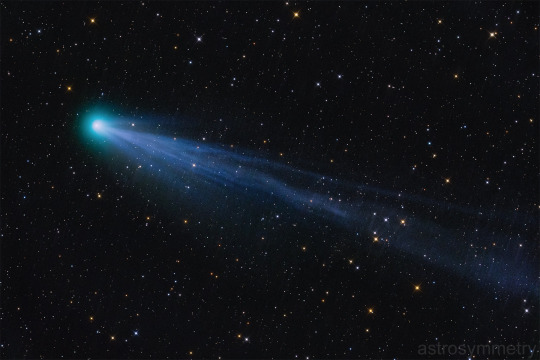
Comet 12P/Pons-Brooks on March 17, 2024 // astrosymmetry
#astronomy#astrophotography#solar system#comet#icy body#kuiper belt#Comet 12P/Pons-Brooks#Comet Pons-Brooks
91 notes
·
View notes
Text
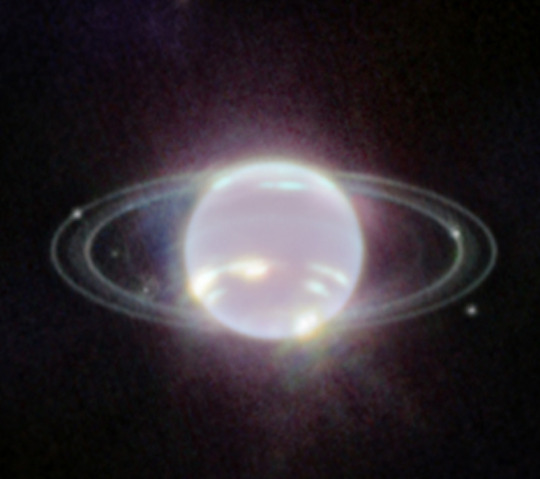
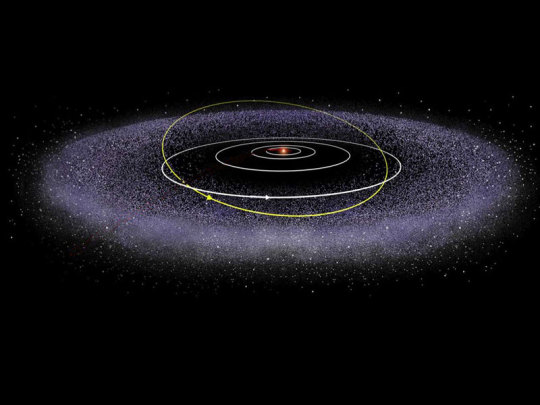
24 notes
·
View notes
Text
now with the official design sheet out of the way
HERES SOME MOTHERFUCKING FANART WE MADE


the second one Will be an acrylic charm as soon as i can afford it
Nix is my very special girl i love her oh so much. the horrors await <3
#sc0rpi0 posts#art#artists on tumblr#digital art#comics#web comic#comicart#comic wip#original art#original character#nix#kuiper belt#satellite
11 notes
·
View notes
Photo

Kuiper Belt Object
23 notes
·
View notes
Text
New(er) Horizons! 🛰️

Originally sent out to studying Pluto in 2006, the mission has been updated to extend its lifetime operation into 2029

Launched on January 18, 2006, NASA’s New Horizons spacecraft has helped scientists understand worlds at the edge of our solar system by visiting the dwarf planet Pluto (its primary mission) and then venturing farther out for a flyby of the Kuiper belt object Arrokoth, a double-lobed relic of the formation of our solar system, and other more remote observations of similar bodies
This new, extended mission will be primarily funded by NASA’s Planetary Science Division and jointly managed by NASA’s Heliophysics and Planetary Science Divisions
“The New Horizons mission has a unique position in our solar system to answer important questions about our heliosphere and provide extraordinary opportunities for multidisciplinary science for NASA and the scientific community,” said Nicola Fox, associate administrator for NASA’s Science Mission Directorate in Washington. “The agency decided that it was best to extend operations for New Horizons until the spacecraft exits the Kuiper Belt, which is expected in 2028 through 2029.”
More information from the Principal Investigator (PI) Alan Stern
For a more complete overview of Pluto and New Horizons: The Pluto System After New Horizons by NASA's New Horizons Principal Investigator Alan Stern, et al

#new horizons#nasa#nasa jpl#Pluto#kuiper belt#heliophysics#planetary science#nasa breaking news#book recommendations#book recs#textbook
5 notes
·
View notes